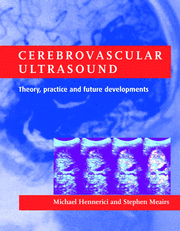Book contents
- Frontmatter
- Dedication
- Contents
- List of contributors
- Preface
- PART I ULTRASOUND PHYSICS, TECHNOLOGY AND HEMODYNAMICS
- 1 Introduction to Doppler ultrasound
- 2 Doppler technology
- 3 Principles and models of hemodynamics
- 4 Computational principles and models of hemodynamics
- 5 Flow patterns and arterial wall dynamics
- 6 Duplex and colour flow imaging
- 7 Misconceptions and artefacts in ultrasound examination of the carotid arteries
- PART II CLINICAL CEREBROVASCULAR ULTRASOUND
- PART III NEW AND FUTURE DEVELOPMENTS
- Index
6 - Duplex and colour flow imaging
from PART I - ULTRASOUND PHYSICS, TECHNOLOGY AND HEMODYNAMICS
Published online by Cambridge University Press: 05 July 2014
- Frontmatter
- Dedication
- Contents
- List of contributors
- Preface
- PART I ULTRASOUND PHYSICS, TECHNOLOGY AND HEMODYNAMICS
- 1 Introduction to Doppler ultrasound
- 2 Doppler technology
- 3 Principles and models of hemodynamics
- 4 Computational principles and models of hemodynamics
- 5 Flow patterns and arterial wall dynamics
- 6 Duplex and colour flow imaging
- 7 Misconceptions and artefacts in ultrasound examination of the carotid arteries
- PART II CLINICAL CEREBROVASCULAR ULTRASOUND
- PART III NEW AND FUTURE DEVELOPMENTS
- Index
Summary
Definitions
A duplex scanning system is one that enables two-dimensional ultrasonic pulse-echo imaging to guide the placement of an ultrasonic Doppler beam and thus to allow the anatomical location of the origin of the Doppler signals to be identified. Since its inception, the common usage of the term ‘duplex’ has changed; what most people now consider to be a duplex scanner is one that has real-time imaging capability with either the imaging transducer itself or, less commonly, a separate transducer being used to collect pulsed or, again less commonly, continuous wave Doppler signals. The processes of imaging and Doppler signal acquisition can either give the impression of being simultaneous or, less commonly, separate and sequential.
A colour flow imaging system is one that superimposes information about flow (or structure motion), coded in colour, on a two-dimensional (or three-dimensional) greyscale image. Whilst this could be achieved by exploring the region-of-interest line-by-line or point-by-point (for example, with a duplex scanner) and representing the frequency or amplitude of the Doppler signals in pseudocolour, the modern use of the terminology is confined to real-time (or, at least, rapid) implementation of the process.
History
The history of the development of ultrasonic pulse-echo imaging, from the earliest demonstration of the medical application of the A-scope through to the advanced high resolution real-time grey-scale scanners of today, is already well documented (Wells, 1978; Goldberg & Kimmelman, 1988).
- Type
- Chapter
- Information
- Cerebrovascular UltrasoundTheory, Practice and Future Developments, pp. 88 - 100Publisher: Cambridge University PressPrint publication year: 2001
- 1
- Cited by



